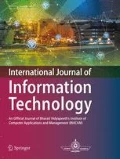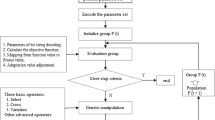Abstract
In any organization, the process of selecting employees is mostly through the traditional methods. These methods do not support hypothetical situations that result in an error in the selection process. In this research paper, a method based on fuzzy triangular number has been used for the recruitment process of individuals. The selection process used is completely different from previously discovered methods. Basically, we use a modified solution to the assignment problem to select the right person by this process. For such type of application areas, genetic algorithm is widely used approach so the authors may use this approach to get the optimum result. Here we also taken GA and solve the selection process through genetic algorithm approach using fuzzy ranking method. During the process of genetic algorithm, we use heuristic crossover and uniform mutation to find the optimal solution. The solution obtained by this process gives a more optimal solution than other methods by which an organization selects more competent/qualified employees than the former, which is useful for that organization in the future. This research paper shows the optimum solution of 10 best applicants from a group of 50 selected applicants through this process.


Similar content being viewed by others
References
Alzyadat T, Yamin M, Chetty G (2020) Genetic algorithms for the travelling salesman problem: a crossover comparison. Int J Inf Technol 12(1):209–213. https://doi.org/10.1007/s41870-019-00377-9
Banerjee A, Ghosh S (2020) FPR: fuzzy controlled rebroad cast in mobile ad hoc network. Int J Inf Technol 12(2):523–529. https://doi.org/10.1007/s41870-019-00288-9
Singh S, Singh S, Banga VK (2020) Design of fuzzy logic system framework using evolutionary techniques. J Soft Comput 24:4455–4468. https://doi.org/10.1007/s00500-019-04207-9
Parihar N (2019) Understanding the recruitment and selection practices of an Indian IT SME (small and medium enterprise). Int J Recent Technol Eng 8(4):12080–12084
Haq E, Ahmad I, Hussain A, Almanjahie IM (2019) A novel selection approach for genetic algorithms for global optimization of multimodal continuous functions. J Comput Intell Neurosci 1–14. https://doi.org/10.1155/2019/8640218
Amjad MK et al (2018) Recent research trends in genetic algorithm based flexible job shop scheduling problems. Math Probl Eng 1–32. https://doi.org/10.1155/2018/9270802
Petrova A (2018) Methodology of estimation of expertsqualification based on professiogram with the use of the fuzzy logic and the psycholinguistic analysis of speech. In: Third international conference on human factors in complex technical systems and environments (ERGO)s and environments (ERGO), pp 82–85, August 2018, https://doi.org/10.1109/ERGO.2018.8443904
Yedaiah V, Haragopal VV (2016) A new approach for solving single objective unbalanced assignment problem. Am J Oper Res 6:81–89
Khandelwal A, Agarwal A (2015) An amalgamated approach of fuzzy logic and genetic algorithm for better recruitment process. TNC Trans Netw Commun 3(3):23–31
Khandelwal A (2014) A modified approach for assignment method to maximize the throughput. Int J Pure Eng Math 2(2):13–19
Chen SM, Chen JH (2009) Fuzzy risk analysis based on the ranking generalized fuzzy numbers with different heights and different spreads. Expert Syst Appl 36:6833–6842
Chen SM, Wang CH (2009) Fuzzy risk analysis based on ranking fuzzy numbers using α-cuts, brief features and signal/noise ratios. Expert Syst Appl 36:5576–5581
Liu L, Gao X (2009) Fuzzy weighted equilibrium multi-job assignment problem and genetic algorithm. Appl Math Model 33:3926–3935
Ye X, Xu J (2008) A fuzzy vehicle routing assignment model with connection network based on priority based genetic algorithm. World J Model Simul 4:257–268
Chen SJ, Chen SM (2007) Fuzzy risk analysis on the ranking of generalized trapezoidal fuzzy numbers. Appl Intell 26:1–11
Huang LS, Zhang LP (2006) Solution method for fuzzy assignment problem with restriction of qualification. In: Proceedings of the sixth international conference on intelligent systems design and applications (ISDA’06)
Jen LC, Ue-pyng W (2004) A Labelling Algorithm for the Fuzzy Assignment Problem. Fuzzy Sets Syst 142:373–391
Chen CB, Klein CM (1997) A simple approach to ranking a group of aggregated fuzzy utilities. IEEE Trans Syst Man Cybern 27(1):26–35
Fortemps P, Roubens M (1996) Ranking and de-fuzzification methods based area compensation. Fuzzy Sets Syst 82:319–330
Kuhn HW (1995) The Hungarian method for the assignment problem. Naval Res Logist Q 2:83–97
Avis D, Devroye L (1995) An analysis of a decomposition heuristic for the assignment problem. Oper Res Lett 3(6):279–283
Eberhardt SP, Duad T, Kerns A, Brown TX, Thakoor AP (1991) Competitive neural architecture for hardware solution to the assignment problem. Neural Netw 4(4):431–442
Chen SH (1985) Ranking fuzzy numbers with maximizing set and minimizing set. Fuzzy Sets Syst 17:113–129
Author information
Authors and Affiliations
Corresponding author
Rights and permissions
About this article
Cite this article
Anju, K., Avanish, K. An advanced approach to the employee recruitment process through genetic algorithm. Int. j. inf. tecnol. 13, 313–319 (2021). https://doi.org/10.1007/s41870-020-00516-7
Received:
Accepted:
Published:
Issue Date:
DOI: https://doi.org/10.1007/s41870-020-00516-7




